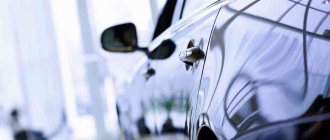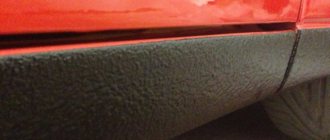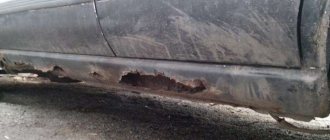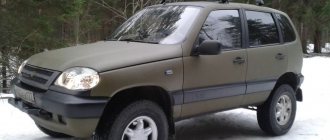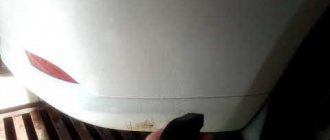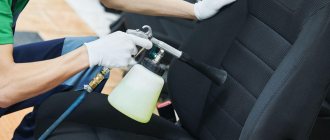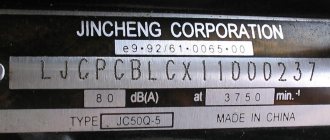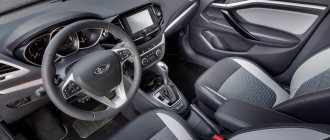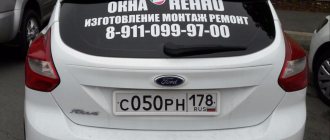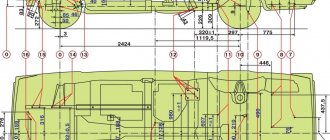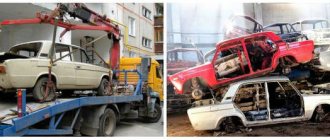The appearance of rust on a car body is an unpleasant phenomenon that can upset any car owner. And if measures are not taken in a timely manner, the damage will spread further, cover a large part, and in the future, severe damage will form in its place, up to the complete destruction of the base of the body. But it is still worth considering that coping with corrosion cannot be done in one day; it takes quite a lot of time. And if something is done wrong, then after a short period the paint at the rust site may peel off and swell again, and you will have to take urgent measures again to protect the body from destruction. And it is better to first familiarize yourself with the main methods of removing rust, consider the main features and rules.
Corrosion formation
Metal corrosion , or simply rust, appears as a result of metal oxidation under the influence of the environment. The main reason for its appearance is damage to the paint on the car body.
All resulting scratches and chips sooner or later become a source of rust formation, which gradually spreads deeper into the stain and over the entire larger surface area of the body.
The rate at which corrosion spreads depends on the aggressiveness of the environment and the condition of the body itself. For example, in the winter season it spreads many times faster.
It is much easier to deal with a single rust stain that has just appeared than with multiple “saffron caps” or an old stain where the metal is corroded almost completely.
The appearance of corrosion that is not yet visible to the eye is indicated by swelling of the paintwork. Such areas should be immediately cleared of old paint and cleaned.
Types of body corrosion
Among the most common types of body corrosion are:
- Chemical. The main catalyst is the surrounding part. The metal product gradually begins to oxidize. The biggest danger is contact with moisture. After all, it may contain various substances and additives. Even air is chemically dangerous for metal, especially in places with a very poor environment.
- Mechanical. Caused by the impact of significant mechanical load on the body. This process especially often manifests itself along with electrochemical corrosion, in places of mutual contact and connection of materials.
- Electrochemical. The likelihood of such body corrosion developing is especially high during the cold season. This is due to the fact that there is a lot of salt, sand and other reagents on the road. In contact with steel, they create a cathode-anode connection. As a result, the metal surface quickly deteriorates.
Vulnerable places
The areas that experience the greatest mechanical stress are the most susceptible to corrosion. These include:
- thresholds are among the first to suffer from corrosion;
- hood – small pebbles from the vehicle in front provoke the appearance of numerous chips;
- wheel arches are constantly exposed to aggressive chemicals.
It is important to promptly detect emerging rust and eliminate it, preventing the further spread of corrosion. To do this, you need to know how you can deal with this unpleasant phenomenon yourself.
Stages of occurrence
Corrosion can occur quite quickly even on new cars. This happens if the car gets into an accident, chips appear, cracks appear in the paintwork, the body is exposed to aggressive chemicals, etc. That is, some processes occur that provoke the occurrence of rust.
But rust also appears under normal operating conditions. Here we are talking about natural wear and tear of the body. Corrosion has several stages of occurrence.
- first stage. Corrosion initially affects the least protected areas. This mainly concerns the joints of metal parts. If you notice hot spots in time, they can be removed with regular sandpaper or other available cleaning products;
- second stage. It is called under-film. The name is due to the characteristic manifestation. Blisters appear on the paint, under which corrosion actively develops due to the ongoing electrochemical reaction;
- third stage. It differs in that the metal body is affected and holes are formed. To combat the third stage, a full range of repair and restoration work is required.
Corrosion Removal Methods
Corrosion can be eliminated in the following ways:
- Mechanical – used for severe corrosion, it involves removing rust by stripping down to metal, followed by priming, puttying and painting the area of the body being repaired;
Advantages of the method: elimination of large and deep stains, damage under swelling paint, as well as low cost and availability of the necessary materials.
Disadvantages: length of the process.
- Chemical - involves using rust removers. Such reagents are widely represented on the modern market.
Advantages of the method: elimination of corrosion in hard-to-reach places, higher process speed.
Disadvantages: inability to use on heavily damaged areas.
Let's consider the process of eliminating corrosion using each of the methods presented above in more detail.
Preparation
Before starting work, you should carefully prepare for the process. Before you paint over rust on your car yourself, inspect the entire car, paying special attention to hard-to-reach areas.
Based on the results of the inspection, an assessment is made of the extent of damage to the vehicle and a method is determined for how the corrosion will be eliminated.
It is also necessary to acquire everything necessary for carrying out repair work:
- degreaser;
- sandpaper;
- putty;
- primer;
- paint;
- grinder;
- special varnish for the car;
- anti-corrosion converter;
- masking tape.
Advice!
Don't forget to have a clean cloth ready. With its help, the body is pre-cleaned from dirt and dust particles.
Step-by-step instruction
Before starting repair work, it is necessary to inspect the body and identify all problem areas. Assess the degree of damage and decide on a method to eliminate corrosion.
Tools and materials
Before starting work you need to prepare:
- grinder;
- sandpaper;
- degreaser;
- putty;
- primer;
- paint;
- car varnish;
- rust converter;
- masking tape;
- clean cloth.
Popular drugs
The most popular chemicals for removing rust from a car body with your own hands are:
- orthophosphoric acid is the most well-known remedy; it can be used in its pure form or be part of various chemistry;
- VSN-1 Neutralizer - easily copes with rust, turning it into a dark mass;
- zinc – a kit for removing rust and further galvanizing the metal by applying a special protective layer using an electrochemical method. Requires connection to battery. The process of working with the Zinkor product can be seen in detail in the video clip:
Often, car owners want to quickly and without unnecessary hassle remove visible traces of corrosion from the car body. In this case, you can use special products, such as Anti-Rust paste.
It will quickly eliminate noticeable rust marks from the surface of the body, but will not eliminate the source of the spread itself. Therefore, this effect will last no more than a month. As a rule, owners resort to this method during pre-sale preparation of the car.
Mechanical method
Removing rust stains mechanically is carried out in several stages:
- cleaning corrosion down to metal with sandpaper. The work can be done manually or using a power tool, such as a grinder. The stain should be cleaned gradually and carefully, avoiding rough scratches. It is important not to damage entire areas of the paintwork and to carry out 100% complete stripping down to “bare” metal.
- treating the prepared area of the body with a rust converter in order to eliminate the smallest corrosion residues that are not always visible to the eye.
- degreasing the surface after the converter ends (on average after half an hour);
- putty (carried out in several layers if necessary) and grinding of the treated surface;
- painting in body color (before painting, protect adjacent parts of the body with newspapers and masking tape and apply an anti-corrosion primer in 2-3 layers). Painting is also carried out in 2-3 layers, each thoroughly drying.
- application of clear varnish (if desired) for more reliable protection and a beautiful appearance.
The result of the work will depend entirely on compliance with all instructions and the correct execution of the work. If the technology is violated, for example, due to poor-quality cleaning or insufficient drying, the result of the work may be completely short-lived.
Watch a video on how to remove rust from a car in 10 minutes:
Chemical method
The significant difference between this method and the previous one lies only in the first stage - cleaning from rusty stains. Instead of mechanical cleaning, specialized chemicals are used. It can remove rust and prevent its further spread without damaging the metal.
As a rule, such preparations are applied to the problem area in accordance with the manufacturer's instructions for the specified time, after which the remaining product is wiped off or washed off.
However, to obtain an excellent and long-lasting result, you will also have to putty, sand and paint. When eliminating minor damage to the body, you can do without these steps.
How to quickly remove rust from a car - electrochemical method
The electrochemical method of removing rust from a car body involves performing an oxidation-reduction process on the affected area. The reaction itself takes place in an electrolyte under the influence of current. This is a complex process. But if you look at it, it turns out that this is the simplest method of getting rid of corrosion.
Advantages of the method:
- Complete rust removal.
- Availability and simplicity.
- Formation of a zinc layer to protect the metal in the future.
- The method is harmless to undamaged paintwork.
- Quick results.
For the procedure you will need:
- A piece of metal wire.
- Two stainless steel electrodes (one with a zinc tip).
- Corrosion converter.
- Zinc chloride solution.
To remove rust you need:
- Connect the wire to the positive terminal of the battery.
- Make a cotton tip on the tip of the electrode and dip it into the transducer.
- Carefully apply the tip to the area damaged by rust.
- Connect the second electrode with a zinc tip to the battery cable instead of the first electrode.
- Make a fabric wrap around the zinc tip.
- Dip the electrode into the zinc chloride solution and run it over the cleaned area of the metal to create a protective layer.
How to remove “saffron milk caps” and “bugs”
Many people want to believe that if rust has just appeared and the lesions are small, then they can be eliminated with some miracle remedy. Unfortunately, this is impossible in principle. The rust that appears on the surface of the paintwork is like the tip of an iceberg; the main damage is deep inside.
There are products on sale that will help remove the red color from the body. For example, there is Anti-Rust paste - it removes red spots quite quickly and well. This is the same rust converter that we discussed above. It eliminates the visible signs, but not the source itself. Such manipulations usually last for 2–6 weeks (depending on weather conditions), and they are most often used immediately before selling the car.
Small “bugs” sometimes cause big problems for the car seller!
If you want to get rid of the problem in the long term, then you cannot do without physical intervention. It is necessary to stop the access of air and moisture directly to the metal. Theoretically, you can prolong the effect of the paste if, after treatment, you cover the damaged area of the body with clear varnish. But it will work if the converter has managed to remove all the rust. In most cases, this does not happen, since the depth of penetration of the product is small.
Unfortunately, it will not be possible to hide damage for a long time only with the help of paste.
The best corrosion converter sprays
The most popular form of release of corrosion converters is sprays.
WURTH
This German product is made using special chemicals. It is easy and convenient to apply even in hard-to-reach areas. After all, there is a long nose here. This converter has excellent penetrating ability, it is perfectly absorbed and instantly dissolves rust.
WURTH protects against further damage and is suitable for all metal surfaces.
Advantages:
- Excellent penetrating ability.
- Squeezes moisture out of electrical contacts.
- Formation of a protective layer.
Flaws:
- High price.
- Very flammable, you have to be careful.
KUDO
This product is made on an acid basis. KUDO deeply affects rust, removes it and protects it from secondary appearance. After treatment, a film is formed on the surface, which reliably protects the car body from subsequent negative influences. The converter has a lasting effect and is not washed off after treatment.
Advantages:
- Quick and easy application.
- Affordable price.
- Dries quickly.
- No smell.
Flaws:
- There is no embossing effect promised by the manufacturer.
Hi-Gear Rust Treatment No-Rust
This is one of the most famous and popular converters among domestic drivers. This is due to the fact that the product contains quite aggressive components. They quickly eat away rust and turn it into soil. Hi-Gear Rust Treatment No-Rust comes in an aerosol spray form. Powerful directional flow ensures deep and uniform penetration of the transducer.
Advantages:
- Maximum penetration of the product.
- Improves adhesion with various types of varnishes and paints.
- Quick results.
- Long-term protection.
- Comfortable application.
Flaws:
- The product will corrode the paint.
- Can only be used outdoors.
- It is necessary to wash off with alcohol.
Where does rust most often appear?
Having analyzed the above causes of corrosion, it is easy to conclude that the problem begins in places most susceptible to moisture, small crushed stone and dirt.
These areas of the body include:
- car thresholds;
- wheel arches;
- hood;
- doors.
The arches rot first, then the sills, and then the doors and hood. If the side of the body hits curbs, the situation only gets worse.
Rating of liquid products
Among the anti-corrosion liquids for the car body, the following are perfect.
FENOM FN956
This is one of the best liquid corrosion converters. Its effectiveness has been proven by many tests - the FENOM FN956 composition easily transforms rust up to 100 microns thick. After drying, the metal surface is covered with a durable crust based on manganese and iron compounds.
Advantages:
- Rust protection for up to seven years.
- Can be easily used for preserving metal without painting.
Minuses:
- Insignificant volume.
- Great cost.
YasKhim
YasChem is a universal and affordable drug. Essentially, it is phosphoric acid diluted with water and additional components. The drug retains its qualities even after defrosting.
Advantages:
- High efficiency.
- Affordable price.
Minuses:
- There is no effect of tinning, galvanizing or other protection.
Chemist
This product easily removes corrosion and protects the body metal from future relapses. After applying the drug Khimik, a zinc coating appears on the surface and a layer of primer is formed. The latter helps to significantly improve the adhesion of the treated metal to paint and varnish.
Advantages:
- It acts quickly and does not require rinsing.
- Prevents relapse.
- Easily removes rust.
- Reliably protects the surface from corrosion.
Minuses:
- Corrodes paint.
- Toxic.
5-painting
- Buy a can of paint that is as close as possible to the color of your car.
- For the best match, find information about the paint shade that was used on your car model's factory paint and select paint from a catalog.
- Before painting, treat the primed surface with fine abrasive (400) sandpaper soaked in water. This will create a flat, smooth surface. Then wash the primer with soapy water and dry.
- Apply the paste in a thin layer, in several approaches .
- Typically the paint takes 24-36 hours to dry.
Gel
Another option for the release form of corrosion converters is gel.
Permatex
This corrosion converter comes in a gel form. It can be easily applied to rusty areas using a spatula. The gel will instantly form a layer of protection. Permatex does not run down and is effective within a couple of minutes after the start of application. In case of a significant layer of rust, another treatment with the drug will be required after half an hour.
Advantages:
- No rinsing required.
- Protects the surface from relapse for a long time.
- Effectively removes any rust.
- Works like a real primer.
- Easy to apply, does not bubble or flow.
Minuses:
- High price.
KerryGel formula KR-240
The main active ingredient of the product is phosphoric acid. It is supplemented with a special structure modifier. The latter destroys the crystalline rust lattice to allow the active substance to penetrate directly into the rust. After the processing process, the metal is coated with a zinc-iron phosphate film. It reliably protects the surface from the reappearance of rust.
Advantages:
- Creates the effect of cold galvanizing.
- Penetrates rust quite deeply.
Minuses:
- Without repeated treatment, it has little resistance to relapse.
- The product must be washed off.
B-52 Vershina
Gel B-52 Vershina has a viscous consistency, which is convenient when applied to vertical metal sheets. The composition does not drip and does not leave puddles or streaks. The reaction with rust is very strong, since the formula of this product includes a mixture of aggressive salts and mineral acids.
Advantages:
- Affordable price.
- Convenient to use.
Minuses:
- Does not convert rust into soil.
- Does not form protective layers on the surface.
Popular drugs
The choice of modern means for combating car corrosion is very wide and choosing the right one for yourself is not so easy. But the most popular among experts remain: orthophosphoric acid or chemicals based on it, VSN-1 Neutralizer, zinc.
When purchasing this or that drug, check what is contained in its composition and carefully read the instructions. Follow the manufacturer's application guidelines, time intervals, and other recommendations to avoid harming your car or yourself during the rust removal process.
Corrosion protection
Follow the simple tips below to protect your car from corrosion:
- wash your car regularly;
- install mudguards (if you don’t have them);
- treat the car with polishing agents (such as “liquid glass”);
- carry out anti-corrosion treatment on the underbody of the car.
Regularly inspect your clean car for problem areas. Remove any small stains that appear in a timely manner. Remember: severe advanced corrosion will lead to expensive body repairs.
Take good care of your car, and then the methods described above will not be useful to you!
Prevention
To prevent rust from appearing on the body, adhere to the following recommendations:
The car needs to be washed regularly, both in winter and summer. This will remove the aggressive components that are sprinkled on the roads, as well as get rid of dust and dirt, under which the metal quickly collapses.- Anti-gravel film is applied to the hood and roof.
- Mud flaps and fender liners must be installed on each wheel.
- Anti-corrosion treatment of the body must be carried out once every 5 years.
The body should be inspected regularly for rust. When the first signs of corrosion appear, emergency measures are taken.
